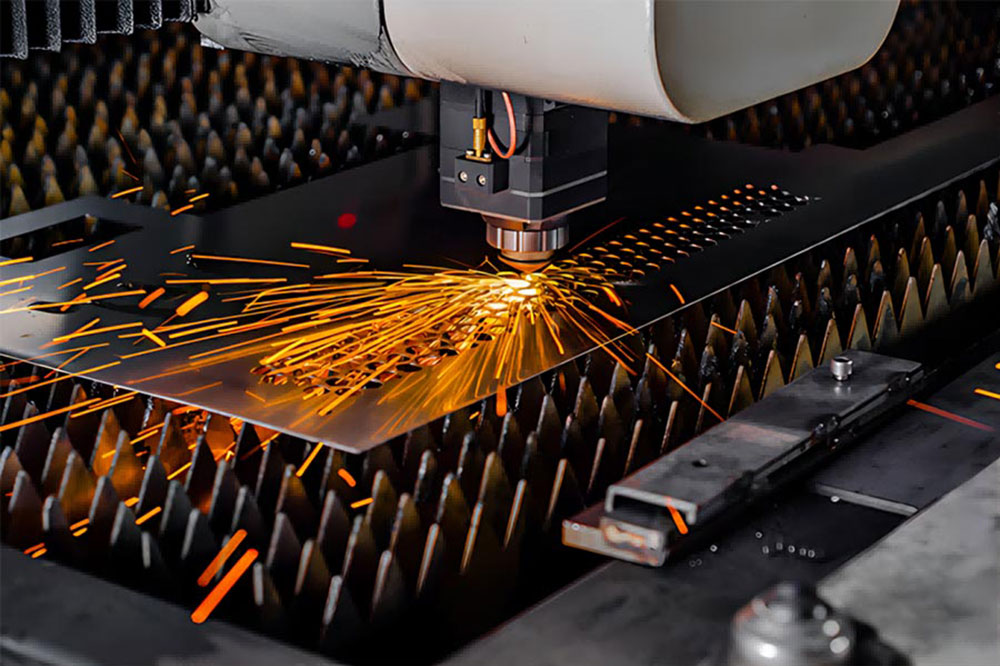Precision Hardware Customized Solutions Manufacturer
Author | Shengwo Industry Insights Team
Updated | October 2025
Contents
Sheet metal fabrication techniques form the backbone of modern manufacturing, enabling the transformation of flat metal sheets into complex, precise components. From automotive body panels to medical device enclosures, mastering these sheet metal fabrication techniques unlocks design flexibility, cost savings, and exceptional product quality. In this guide, we’ll explore every facet of sheet metal fabrication technology and design, equipping you to choose the right methods, maintain tight tolerances, and optimize your production.
Understanding the landscape of sheet metal fabrication techniques is essential before diving into specifics. At its core, sheet metal fabrication involves:
Cutting: Dividing raw sheets into required shapes
Forming/Bending: Shaping sheets into three-dimensional parts
Joining: Welding, riveting, or fastening parts together
Finishing: Surface treatments to improve durability and appearance
Each of these stages relies on specialized equipment and design know-how to ensure parts meet specifications and performance criteria.

Laser Cutting: Uses a focused laser beam for high-precision cuts and narrow kerfs; ideal for intricate patterns.
Plasma Cutting: Employs ionized gas to slice through thicker metals quickly; best for structural parts.
Waterjet Cutting: A cold-cutting process using high-pressure water (often with abrasives) to prevent heat distortion.
Shearing & Sawing: Mechanical methods for straight cuts; cost-effective for simple geometries.
These cutting methods are the first step in many sheet metal fabrication techniques, determining material yield and edge quality.
Press Brakes: Hydraulic or mechanical brakes apply force to bend sheet metal to specific angles.
Roll Forming: Continuously bends a long strip through rollers to create profiles like channels and tubes.
Stretch Forming: Stretches and bends sheets over a form block for smooth curves in aerospace and architectural applications.
Accurate control of bend radii and springback compensation are critical design considerations when employing these sheet metal fabrication techniques.
TIG/MIG Welding: Fusion welding techniques that produce strong, seamless joints for stainless and carbon steel.
Spot Welding: High-speed resistance welding for thin sheets, common in automotive assembly.
Mechanical Fastening: Rivets, nuts & bolts, or clinching used when heat-free joining is required.
Choosing the right joining method impacts assembly speed, joint strength, and post-process finishing.
Powder Coating: A durable, uniform finish that withstands impacts and frequent cleaning.
Anodizing: Electrochemical treatment for aluminum that enhances corrosion resistance and allows color coding.
Galvanizing: Zinc coating for steel parts to prevent rust in outdoor or harsh environments.
Electropolishing & Passivation: Chemical treatments to smooth stainless steel, remove free iron, and improve biocompatibility.
Finishing is the final—and often most visible—step in sheet metal fabrication techniques, protecting parts and enhancing aesthetics.

Standard Tolerances: ±0.5 mm for cuts; ±1–2° for bends on typical gauges.
Tight Tolerances: ±0.1 mm achievable on laser-cut parts; ±0.5° on precision bending.
Design for Tolerance: Account for bend allowance and material springback when creating CAD models.
Maintaining proper tolerances ensures parts fit together tightly and function correctly without costly rework.
Minimize Part Complexity: Reduce the number of bends or joints to lower costs and lead times.
Optimize Bend Angles: Use standard press-brake tooling angles (30°, 45°, 90°) whenever possible.
Include Relief Cuts: Prevent tearing at sharp internal corners by adding small relief notches.
Plan for Nesting: Design sheet layouts to maximize material usage and reduce scrap.
Specify Material Thickness: Match part function to appropriate thickness to balance weight and strength.
By integrating these sheet metal fabrication techniques design tips early, you can streamline manufacturing and improve yields.
Carbon Steel: Affordable, strong, easy to weld—used in structural and general-purpose parts.
Stainless Steel (304/316): Excellent corrosion resistance and hygiene—ideal for food, medical, and marine applications.
Aluminum Alloys (5052, 6061): Lightweight and formable—preferred in aerospace, automotive, and electronics housings.
Copper & Brass: High conductivity—used in heat sinks, electrical components, and decorative elements.
Corrosion Resistance: Choose galvanizing or anodizing for outdoor or corrosive environments.
Sterilization Compatibility: Electropolishing and passivation for medical and food-handling equipment.
Visual Appeal: Powder coating or anodized color coding to support branding and differentiation.
Wear Resistance: Hard anodize or specialized coatings for parts subject to abrasion.
Combining the right material with an appropriate finish is a hallmark of advanced sheet metal fabrication techniques.
Automotive: Body panels, chassis components, brackets, and heat shields.
Aerospace: Wing ribs, ducting, brackets, and fuselage frames.
Medical: Equipment enclosures, surgical trays, and instrument stands.
Electronics: Enclosures, chassis, heat sinks, and EMI shields.
Architecture: Facade panels, decorative screens, and support structures.
Across industries, the adaptability of sheet metal fabrication techniques enables both functional and aesthetic designs.

Cost-Effectiveness: Low tooling costs for small runs; scalable to mass production.
High Precision: CNC-enabled cutting and bending for tight tolerances.
Design Flexibility: Ability to prototype and iterate quickly.
Material Efficiency: Nested layouts and minimal scrap with laser cutting and CNC programming.
Material Limitations: Thicker sheets can be harder to bend and may require specialized presses.
Complex Geometries: Intricate 3D shapes may need multiple setups or secondary operations.
Surface Quality: Additional finishing steps add time and cost.
Tolerance Stack-Up: Multiple bends and joins can accumulate tolerance errors.
Understanding these trade-offs helps you select the right sheet metal fabrication techniques for your project.
Standardize Stock Sizes: Leverage common sheet dimensions to reduce waste.
Simplify Part Geometry: Fewer bends and features mean faster cycle times.
Batch Similar Parts: Grouping similar designs optimizes machine setup and changeover.
Optimize Nesting: Use advanced software to place parts tightly on the sheet.
Select Dual-Purpose Processes: Combine laser cutting and punching in one setup when possible.
Minimize Secondary Finishes: Apply only essential surface treatments.
Design for Manufacturability: Collaborate with fabricators early to avoid late-stage changes.
Implement Quality Controls: Catch errors early to prevent costly rework.
Applying these cost-reduction strategies within your sheet metal fabrication techniques will boost profitability and lead-time.

At Shengwo, we combine more than a decade of expertise with cutting-edge equipment to deliver exceptional sheet metal solutions:
Advanced CNC Technology: Fiber lasers, CNC press brakes, and automated punch/laser combos.
Experienced Team: Skilled engineers, programmers, and technicians dedicated to quality.
Full-Service Capabilities: In-house cutting, forming, welding, and finishing for streamlined delivery.
Quality Assurance: ISO-certified processes and rigorous inspection ensure consistent results.
Customer Focus: Rapid quoting, flexible batch sizes, and design-for-manufacturing support.
Partner with Shengwo for precision, speed, and reliability in every sheet metal project.
Mastering sheet metal fabrication techniques empowers manufacturers to produce high-quality, precision parts across diverse industries. From understanding cutting and forming processes to selecting materials and finishes, every decision impacts cost, performance, and aesthetics. By applying best practices in design, tolerance control, and process selection, you can unlock efficiency and innovation in your production.
Ready to bring your designs to life with industry-leading sheet metal fabrication techniques? Contact Shengwo today for a free quote and expert guidance.
Q1: What are the main sheet metal fabrication techniques?
They include cutting (laser, plasma, waterjet), forming (press brake, roll forming), joining (welding, riveting), and finishing (powder coat, anodize).
Q2: How do I choose the right material and finish?
Select materials based on strength, weight, and environment; match finishes for corrosion resistance, aesthetics, and sterilization needs.
Q3: What tolerances can be achieved?
Standard is ±0.5 mm for most bends and cuts; high-precision laser systems can hold ±0.1 mm or better.
Q4: How can I reduce sheet metal fabrication costs?
Simplify designs, optimize nesting, batch similar parts, and minimize secondary processes.
Q5: Why work with Shengwo for sheet metal fabrication?
Shengwo offers leading CNC technology, full-service capabilities, experienced staff, and ISO-certified quality—all at competitive rates.